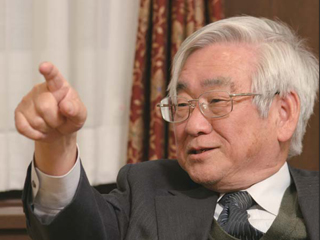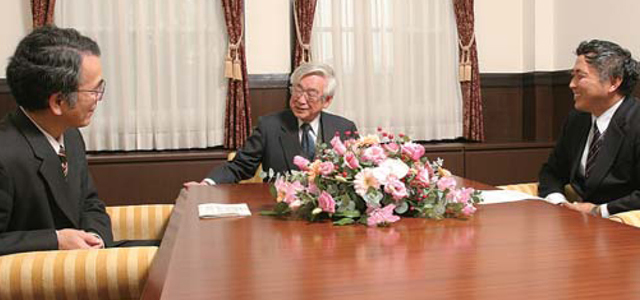INTERVIEW
Dr. Maskawa talk about his early prize winning research

Toshihide MASKAWA
- Born in 1940
- 1962 Graduated from Faculty of Science, Nagoya University
- 1967 Completed doctoral program, Graduate School of Science, Nagoya University,
- 1967 D.Sc., Nagoya University
- 1970–1976 Assistant Professor, Faculty of Science, Kyoto University
- 1980–1990 Professor, Yukawa Institute for Theoretical Physics
- 1990–1997 Professor, Faculty (and Graduate School) of Science, Kyoto University
- 1997–2003 Director, Yukawa Institute for Theoretical Physics
- 2003– Professor Emeritus, Kyoto University
In the autumn of 2008, two physicists who spent their early lives as researchers at Kyoto University received the Nobel Prize in Physics. They are Dr. Toshihide Maskawa (Professor Emeritus at Kyoto University) and Dr. Makoto Kobayashi (Professor Emeritus at the High Energy Accelerator Research Organization).
Their 'Kobayashi-Maskawa Theory', which earned them the award, was published in 1973. They formulated their idea while the two working together at the Department of Physics, Kyoto University.
Commemorating that honor, we had an opportunity to have an interview with Dr. Maskawa and Prof. Taichi Kugo, the former director of the Yukawa Institute for Theoretical Physics. (The interviewer is our chief editor, Mitsuhiro Shishikura, professor of the Graduate School of Science)
Mitsuhiro Shishikura: Dr. Maskawa, Congratulations on receiving the Nobel Prize in Physics. Could you explain your work with Dr. Kobayashi which earned the prize?
Toshihide Maskawa: As you know, matter in our world consists of atoms. An atom consists of a nucleus and electrons, and the physical laws which govern them were revealed by Heisenberg and Schrödinger by 1926. Further research revealed that a nucleus consists of protons and neutrons. Around 1955, via cosmic rays, new particles were found one after another. Then Prof. Shoichi Sakata at Nagoya University put forward a model, the Sakata model, in which three of 20 or so elementary particles which had been discovered were fundamental particles, with all the rest being made up from combinations of those three. Later this model was developed into the quark model of Gell-Mann and Zweig. At the same time the dynamics of those particles were studied. The biggest discovery, by Lee and Yang in 1955, was that the law of physics is not symmetric as in mirror symmetry (replacing left and right). It was then proposed that the law should be symmetric when you interchange particles with and anti-particles at the same time as you interchange left and right. This is called CP symmetry. Later on, it was experimentally discovered by Fitch and Cronin that CP symmetry is also broken, although at a much weaker level than mirror symmetry. When this discovery was published, I was in the second year of my master course and had just joined Prof. Sakata's lab. In the lab, we had 'journal club' whereby we took turns reading recent articles from journals and presenting them to the rest of the lab. When it came to my first turn to do the journal reading, there was the article about the discovery of the violation of CP symmetry, by Fitch and Cronin.
Taichi Kugo: Was that the first report of CP symmetry violation?
TM: Yes, it was.
TK: Since your lab mates took turns reading the journals, do you think it could have been someone else who noticed the article?
TM: Yes, it was simply a stroke of fate.
TK: When the results of the experiment on CP symmetry violation came out, were there a lot of physicists trying to explain it?
TM: No. No, there weren't.
MS: How did you come to have the idea of constructing a theory to explain the CP symmetry violation?
TM: Ever since I knew about the Fitch and Cronin article, I'd feltlike there was something stuck in my throat. Then in 1971, 't Hooft and Veltman showed that weak interaction was a renormalizable theory. At that stage, I thought that with that theory it might be possible to explain CP symmetry violation. Likewise, Dr. Kobayashi, who was at Nagoya University at the time, was interested in CP symmetry violation. And so when he moved to Kyoto University in 1972, I suggested to him that we might work together.
MS: And did you divide the work up between the two of you?
TM: Kobayashi can do just about anything, whereas I'm no good at the experimental side. And so I proposed number of models which could possibly bring about CP symmetry violation, and Kobayashi would think about whether it would be compatible
with already known various experimental facts.
MS: It's been said that the idea behind the Kobayashi-Maskawa Theory came to you while you were in the bath…
TM: It was just not possible to solve the CP symmetry violation problem with the 4 flavor model, and there was one time when I made the right-handed current model, but the next day Kobayashi cautioned me that that wouldn't work either. When I got home and took a long hot bath, and started to think if there was any way to breathe new life into this. But however I looked at it, the 4 flavor model was a non starter. It's embarrassing to admit, but I thought there was nothing else but to write it up in a paper as an example of a theory which had failed. When I got up out of the bath, the 6 flavor model came to me. Just as I was thinking of writing it up as a failed theory, the major premise that I'd been obsessed with, namely that there should be 4 flavors in the model, just disappeared. And so the next day, I proposed to Kobayashi that we should write a theory based on a 6 flavor model. Kobayashi agreed on the spot, not even wanting to think about it overnight. That was at the end of June, and September 1st we submitted it to the Progress of Theoretical Physics, published by the Yukawa Institute for Theoretical Physics at Kyoto University and the Physical Society of Japan. It came out in the March edition of the following year, 1973.
TK: The Yukawa Institute for Theoretical Physics is a focal point for research in elementary particle theory, not just in this country but internationally as well. So while the research institute certainly is a part of Kyoto University, it goes beyond the university's boundaries. In that sense, did you have any special feelings in 1970 when you were about to come up to Kyoto?
TM: Indeed, Kyoto University was very advanced in field theory, and so looking at it from Nagoya, I was filled with anticipation for the future.
TK: I entered the Physics Department of Kyoto University in 1971, but I don't necessarily remember it as feeling like a center for field theory at that time. It was more the case that Dr. Maskawa brought field theory to the Physics Department at Kyoto University. Dr. Maskawa first introduced Weinberg's paper 'A Model of Lepton' in our laboratory in December of 1971. Field theory was not fully accepted at that time anywhere in the world, since it is more or less ineffective with regard to strong interaction, and so this was a very fresh story. The very existence of quarks was still only half believed by people, so it was actually just Dr. Maskawa's sense which led him to think that this theory could open up an important new direction in the future. MS: Have you been fond of arithmetic and science ever since you were little?
TM: Every day when I was at primary school, I used to play until late in the evening. I didn't used to study much, so one day my mother apparently told the teacher, "Our son doesn't do any studying at all, so would you please give him some homework?" And then the teacher said, "But I do give out homework every day. Your son doesn't do it."(laughs) What got me started on studying was when I discovered books. As a boy at primary school, there was something I had to find out about, and so I went to the local library and opened up a book, I can't remember now, what book it was, but I do remember feeling terribly excited for some reason. Ever since then my world has revolved around books.
MS: What made you go into the world of physics?
TM: When I was in senior high school in Nagoya, I read in a local newspaper that Prof. Sakata had done some outstanding world class research in particle physics and thought simply, "I want to work in that field", and set my sights on Nagoya University. I can say that Prof. Sakata motivated me the most at that time. But our family ran a business dealing with sugar for onfectionary, and there was a serious shortage of labor at the time, and so my father was counting on me to help out with the business. And so I promised him that I would only sit university entrance exams one time.
TK: And if you'd failed, you would have gone into the family business.
TM: That was the only time in my whole life, you know, up to this point, that I'd really put all my effort into studying.
TK: Did you aim to be a physicist right from entering university?
TM: The first university researcher I ever saw was a terrific professor called Fujio Nakano, who was in his early 30s at the time. Whenever we went to ask him a question, we would be told to go and find out the answer for ourselves. Rather than spoon feed his students, he taught us how to plug away at finding things out, and so become researchers by collecting information by ourselves. From that time I became to greatly admire researchers. I was interested in all sorts of fields besides physics, and I even studied about the brain with my fellow students for about three months. If I'd gone into the Medical School, I might have become a cerebral physiologist, you know. (laughs) Even now, I'm interested in evolution. But anyway, I didn't take it that far, and ended up eventually in Prof. Sakata's lab. That was the second year of my master course.
MS: I heard that you often think about things while you're walking around…
TM: I can't think if I don't walk about. As soon as I sit down in front of a desk my thought processes stop. (laughs) It's the same if there's anyone next to me. So, anyway, I walk about, mainly.
TK: I heard something about you almost having had a traffic accident…
TM: I always speaks to my wife that if I ever had a traffic accident, it would be my fault. (laughs) No, joking apart, I got yelled by truck drivers three times. They said, "Which way are you walking? You've got a red light, you know!"
MS: Don't you find Kyoto a good city to walk around in while you're doing your thinking?
TM: In winter the Philosopher's Path is good. It's interesting to see the Kitashirakawa canal crossing above a natural river at one point. I love to talk about these things. (laughs)
MS: Finally, do you have any message for those from abroad or in Japan who are going to study at Kyoto University?
TM: When you're doing research, you quite often have to do things which are off your main theme, things which you may be averse to. But it's important to set your target as high as possible and not to lose sight of your goal even when things do get tough. Always keep at it, plug away at your experiments or whatever hands-on stuff you're doing everyday. It is also important to exchange ideas freely with your friends and seniors.


